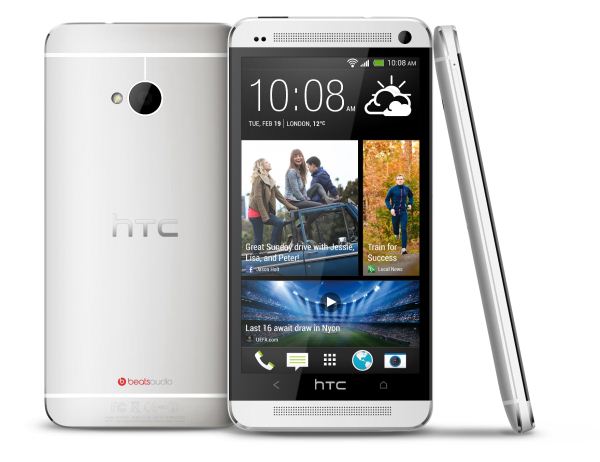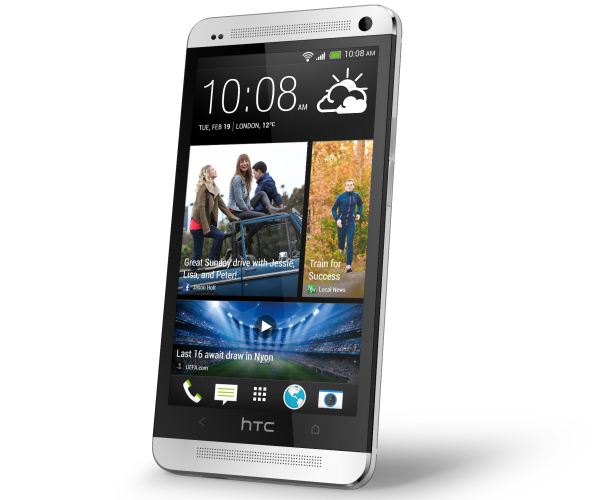Hands on and Impressions from the HTC One - Formerly M7
by Brian Klug on February 19, 2013 10:30 AM EST- Posted in
- Smartphones
- HTC
- Mobile
- HTC One
- Snapdragon 600
HTC is in an interesting position as a result of this last product cycle. While the previous HTC One series’ industrial design and performance was top notch, other OEMs still managed to eclipse the One series in terms of market adoption and consumer perception. Getting back to being a solid performer and cementing a place as at least the dominant number three player in the smartphone space is HTC’s mission for 2013, and the flagship device it’s starting that out with is the device previously known as M7, now known simply as the HTC One.
Design and Construction
The choice of the HTC One name really emphasizes how much this launch means to HTC — this is the canonical One. This is the fullest expression of HTC’s view for what the One lineup should mean, this is their flagship. The One is a clear evolution of the industrial design first begun with the Butterfly and DNA, except instead of plastic the One is machined from a single solid block of aluminum. There are over 200 minutes of CNC machine cuts per device, which is a unibody construction. Plastic is injected into the aluminum block after certain cuts are made for the back case, which then gets machined into the final form. The One uses the top and bottom aluminum strips for antennas, both of which are actively tuned to mitigate unintended attenuation from being held. There’s a plastic insulative strip in-between the two antennas and the main body. In spite of being aluminum, the One also includes NFC, whose active area surrounds the camera region. There’s no wireless charging from Qi or WPC, however.
In the hands the HTC One has the kind of fit and finish that I’d expect from a high end device. I thought that the One S was perhaps the best industrial design of 2012 in part thanks to the metal backside, unique concave shape, and size. The truth is that the HTC One feels even better than that. There’s something inescapable about metal — HTC described it as expensive and luxurious feeling, like a well crafted tool. Other OEMs with metal phones like to evoke imagery of watches or high end jewelry. I think at some fundamental level metal does imply value, and as a result it conveys a much higher end in-hand feel than other entirely polycarbonate plastic designs. There’s a thin strip of plastic which runs around the edge of the device, and it’s here that the microSIM tray, ejection port, primary microphone, microUSB port, power/lock button (which doubles as IR transmit and receive), earphone jack, and volume rocker sit. The front has two aluminum pieces which serve as the speaker, microphone, and earpiece grilles. The HTC One will come in both an uncolored silver version, and anodized black.
The One is topped with a 4.7-inch 1080p Super LCD 3 display. We’ve said that 2013 is going to be the year of 5-inch phones, and 4.7 is just shy. I think there’s something almost optimal about the device size that results with a 16:9 display size just short of 5-inches diagonal. It’s still possible to one hand if you have medium sized hands, easy to pocket, and still not laughably huge.
The HTC One at first glance might seem reminescent of another big metal unibody device, but in the hand couldn’t feel any more different. The convex rounded back side gives the One an entirely different in-hand feel, and the edges have a slight negative angle to them in addition to two chamfers.
Rather than place the primary speaker on the backside of the One, HTC has placed a set of speakers on the front of the device, one at top, one at bottom, behind the two grilles. These two provide stereo sound, and placing them on the front instead of the bottom or back makes a lot of sense for things like watching video, Google Navigation, and listening to music. The One also has dual microphones for noise rejection on calls, and also two different microphone pairs for accommodating low volume and high volume environments when recording audio. For example the commodity microphones generally included in a smartphone saturate around 70 dBA, HTC claims the dual microphone system on the One can accommodate up to 120 dBA SPL (Sound Pressure Level) without saturating.


















139 Comments
View All Comments
flyingpants - Tuesday, February 19, 2013 - link
I didn't mean to imply my 16 hours thing was was a realistic workload. It's just an extreme example of the most you could possibly do with a phone. It's not necessary to go that far, but if any manufacturer did, it would put battery anxiety to bed permanently. No matter what you did, you wouldn't be able to kill the phone within a day unless you ran something that consumed 100% CPU the whole time.repoman27 - Tuesday, February 19, 2013 - link
"The proper way to measure smartphone battery life is with benchmarks. Anandtech doesn't innovate much in this area and I expect a lot more from my favourite tech website. Even ultra-nerd smartphone editor Brian Klug is guilty of the "It lasts me allll day!" blunder."Whoa, what site have you been reading? I'm not sure there's anyone on the planet more obsessed with battery life testing than Anand. It takes time to do those tests, they're not completed yet. This article is titled "Hands on and Impressions" not "Brian Klug's Definitive Review". This piece is just to coincide with the media event earlier.
flyingpants - Wednesday, February 20, 2013 - link
Well... GSM Arena for one. They do a video playback test (screen-on time!) and a standby test. Anandtech does neither of these.As for someone out there being more obsessed with battery life testing than Anand (or Brian), I can safely say that I am. I can't tell you how many times I've forgotten to charge my phone, or forgot to bring a charger, or had to make a quick stop to charge at a Starbucks or something.. Or the amount of times I've had to text someone "Hey, I'll talk to you later, I have 1% battery". Then I'm just unreachable.
Phones have already replaced GPS devices/iPods/Point & Shoot cameras for many people.. Soon they will in effect start to replace computers as well. Within 3-5 years we'll have Ivy bridge-like performance on phones, using them with wireless displays and keyboards.. Wouldn't it be great if we established a "16-hour actual usage life" precedent before all that, while it's still relatively easy?
I use an app called My Battery Analyser and it does nothing except chart each time the battery drops by 1% for easy readability, and give you a figure of % drop per hour. This is very useful for testing how much charge a specific app uses, or finding out if your phone is mysteriously losing 5% charge overnight when it's supposed to be perfectly idle. I've done some testing with interesting results. For example, using Skype over 3G on my SGS3 gives a consistent 23%/hr drop, or just over 4 hours of life. Terrible! But guess what? Heavy SMSing (0% Brightness, everything OFF) doesn't fare much better.
I'd like to see a test just sending SMS constantly every few seconds with the screen on. MANY people text more than talk nowadays.
A test that measures screen time while displaying mostly static content, like an e-book, would be nice. The Anandtech web browsing test is useful as a comparative tool, but if I were ever to spend 5 hours browsing the internet, most of it would probably be spent looking at the same page for at least minutes at a time, not loading new pages every 10 seconds.
And why not do a video playback test? I remember being really confused by this.
I'd also love to see a proper standby test, to see if the software pre-installed on the phone (widgets and Samsung apps and whatnot) causes drops in standby life, and exactly how much % you are losing per day to this nonsense. This could be done with My Battery Analyser or an equivalent app. You'd charge the phone to 100%, turn everything off but leave Wifi on, reboot it, put it to sleep, wait for it to discharge. Every modern smartphone should last at least a week.
I don't know what you refer to at the end, I didn't mention anything about the tests for the HTC One being complete or not.
xaml - Tuesday, February 19, 2013 - link
"While the previous HTC One series’ industrial design and performance was top notch (...)"Well, my beautiful black One S peeled itself, all replacements seemed to, too and so I ended up with the silver version that was neither as nice looking or as comfortable to touch.
DukeN - Tuesday, February 19, 2013 - link
Once again I refuse to buy anything with Beats on it.Lame, HTC, lame.
bigboxes - Wednesday, February 20, 2013 - link
So, you read the whole article, saw what an awesome phone it was, found out that it had Beats Audio and decided it was a deal killer. Hint: You can turn off Beats Audio.Lame, DukeN, lame.
themossie - Thursday, February 21, 2013 - link
You won't buy anything with an equalizer and higher line-out voltage? The line-out voltage is even useful... and if you don't like the equalizer, turn it off.repoman27 - Tuesday, February 19, 2013 - link
Or you can simply make 1M devices in one year by having 1,000 machines in your factories. (52 * 6 * 12 * 1000 = 3,744,000 hours of CNC time) And your hourly rates have nothing to do with the going rates in China at the moment.flyingpants - Tuesday, February 19, 2013 - link
Yes, because I'm sure HTC manufactures only one phone body at a time, at a cost of $80 each. Are you out of your mind?noblemo - Tuesday, February 19, 2013 - link
I am a huge proponent of attentive industrial design and incorporation of non-synthetic materials, so the machined aluminum body with front-facing speakers commands big love. Although the 2013 HTC One is presumably well positioned against the iPhone and Galaxy S4, my next smartphone purchase will likely be either the next Nexus or a pen-toting phablet. The tradeoff is fairly straightforward: either I save $300 on an extremely capable handset with rapid OS updates (i.e. Nexus 5/X), or I spend $600+ on a multi-tasker like the Note III. YMMV